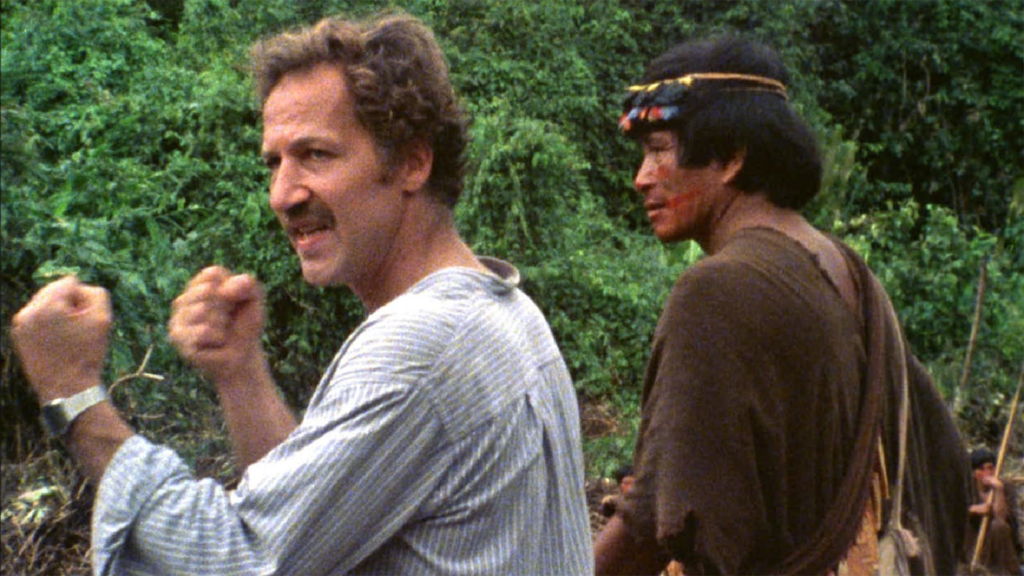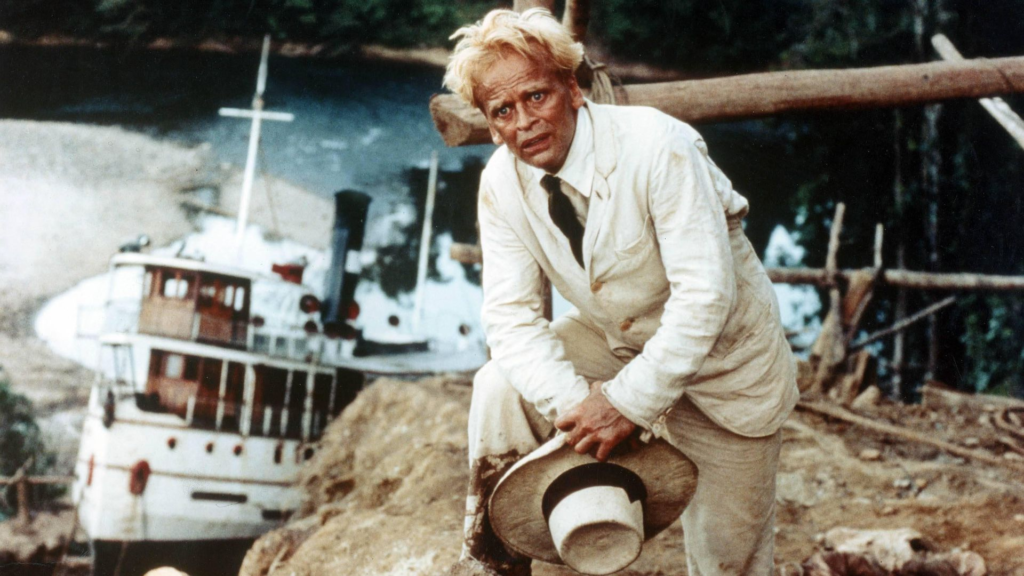| Chris Polley |

Fitzcarraldo screens at the Trylon from Friday, November 19 to Sunday, November 21. Scroll to the bottom of this page for tickets and more information.
In Werner Herzog’s stirring 2005 documentary Grizzly Man, the director inserts himself carefully into the narrative as he contemplates the tragic and preventable death of grizzly-bear enthusiast and environmentalist Timothy Treadwell. Treadwell was mauled to death by the animals he was attempting to protect and film in 2003, all while letting his camcorder record (with the lens cap on) the audio of his demise. “I believe the common denominator of the universe is not harmony, but chaos, hostility, and murder,” Herzog narrates as he concludes his journey toward understanding Treadwell’s life and its end.
These words, forever imprinted in my mind, feel particularly apropos in the world of film news recently, with the tragic on-set death of cinematographer Halyna Hutchins last month. While the camera wasn’t yet rolling when Hutchins was shot and killed by a prop gun handled by actor Alec Baldwin, the incident has already been replayed, picked apart, and documented by press outlets and amateur online commentators worldwide.
This parallel causes me to wonder if, while making Grizzly Man, and especially while writing and recording those chilling voiceovers, Herzog was thinking at all about the unfortunate events that occurred while filming Fitzcarraldo, his 1982 dramatization of the life and exploits of Carlos Fitzcarrald, a European rubber baron that brings a deranged vision to the jungle of Peru. The historical epic centers on this monster with a slight name-change—Bryan Sweeney Fitzgerald––played with manic precision by Klaus Kinski. Fitzgerald is an imperialist businessman looking to bring art to a people that never asked for it, and the film follows his trek into Peru and down the Amazon in an attempt to excavate and sell enough rubber to raise funds for constructing and opening an opera house in the South American jungle. The locals redub him “Fitzcarraldo” for easier pronunciation, not unlike how foreign names become Americanized for immigrants in this country, thus making the film’s title a nod to the idea of how someone’s identity can so easily become subsumed by their immediate surroundings.
Like Fitzgerald, Herzog seemed to lose control of his own attempt to bring Western art to an alien environment. The on-location production of Fitzcarraldo in Peru was beset with tragedy and injury, although it wasn’t considered newsworthy at the time (whether because of the remote filming location, lack of an American movie star at the center of it, a less whirlwind film production news cycle, or some combination of the three). Film editor Catherine Shoard looks back in her primer about on-set accidents for The Guardian, specifying that the 1981 shoot “resulted in numerous injuries and the deaths of several indigenous extras. One Peruvian logger was forced to amputate his own foot after being bitten by a venomous snake.”[1]

While this is hardly surprising considering all the clues both textual and subtextual in the finished product, it’s not something I explicitly knew about until researching the film in advance of writing this piece. In my previous watches and fumbling around on the internet as the credits rolled, I learned plenty of other things: how Jason Robards was originally the lead, that it took some coaxing for Herzog to secure longtime mercurial collaborator Kinski to be his replacement (who famously walked off mid-shoot during the filming of another of the duo’s iconic works, Aguirre, the Wrath of God), and even that the tension between Herzog, Kinski, and the locals led to a particularly pervasive story fed by the auteur’s mythical status that a local tribal chief offered to have Kinski murdered as a favor to the filmmaker. To learn this new information just days after the internet’s onslaught of reporting and editorializing on Hutchins’s accidental death was unsettling, to say the least.
What has become of this beloved work of art to me now? I started factoring in the imperialism of Fitzcarraldo’s narrative compared to what happened last month. My stomach turned. I knew Hutchins’s name, but nobody seemed to even care to write down the names of the people maimed and killed on Herzog’s set—probably because they were local indigenous people to Peru, essentially nameless to the Western world.
And for all the newfound clarity regarding on-set safety brought to the forefront in the wake of Hutchins’s death, criticism of Herzog’s epic upon its release in 1982 was not hard to find now that I was looking for it. In fact, Washington Post critic Gary Arnold seemed to particularly see through the grandeur that many (myself included for over a decade) could not, writing, “To remain intrigued with this movie you are obliged to go along with the pretense that Herzog’s continuing elaboration of a cherished personal myth––the impossible dreamer, the director attracted to primitive locales and dangerous circumstances in his quest for elusive, visionary images ––is a theme of surpassing interest.”[2]
Now, I admittedly do still value dissecting this theme so many years later, especially considering today’s landscape of an enduring ego-obsessed patriarchal hegemony. Ironically, the sheer audacity and singularity of Herzog’s understanding and conveyance of the human spirit as a filmmaker, artist, and thinker remains unparalleled. This story is still, nearly 40 years later, one that resonates, especially in a world that repeatedly wrestles with the concept of a white devil disguised as a white savior (even down to the white linen suit and shock of strangely styled hair). Yet, I still ask myself: is it worth it in the face of such catastrophe, such literal loss of life?

In an interview for the Directors Guild of America, Herzog himself said of the scope of the infamous central event of the film (a 340-ton ship pulled across a mountain using an elaborate system of pulleys and winches sans special effects/movie magic of any kind), “I had staged a huge mechanical event, which is out of proportion for a film, and then I just covered it the best I could.”[3] This is not just an admittance of how art, when in the hands of someone with an unrelenting vision, can become just as unwieldy as Fitzgerald’s plans for getting rubber out of an inaccessible part of the Peruvian jungle—it’s perhaps a confession that playing with cameras, actors, and king-size props is, yes, akin to the old theological warning about playing God.
NOTES
- Catherine Shoard, “‘No one should be killed on set’: tragic history of fatalities during filming,” The Guardian, October 22, 2021, https://www.theguardian.com/film/2021/oct/22/on-set-fatalities-halyna-hutchins-alec-baldwin
2. Gary Arnold, “Visions of Vanity,” The Washington Post, November 9, 1982, https://www.washingtonpost.com/archive/lifestyle/1982/11/09/visions-of-vanity/821978fa-3843-4fc1-9c2b-2da7de9cc0db
3. Jeffrey Resner, “Werner Herzog: Mountain Climbing,” DGA Quarterly, Fall 2007, https://www.dga.org/Craft/DGAQ/All-Articles/0703-Fall-2007/Shot-To-Remember-Fitzcarraldo.aspx
Edited by Brad Stiffler and Michelle Baroody
